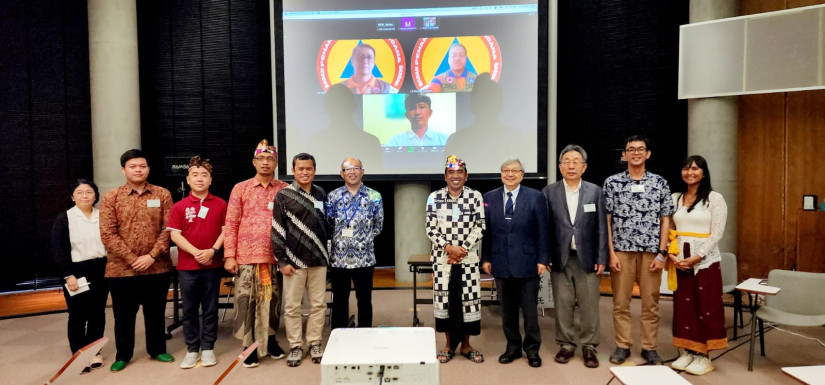
A volcanologist from the UGM Faculty of Mathematics and Natural Sciences, Dr. Wiwit Suryanto, together with his fellow from Udayana University, I Nyoman Sukma Arida, joined the Mount Agung Slope Volunteer Community Team on a visit to Yamanashi Prefecture, Japan, from June 10th to 20th.
One of the agendas of the visit was to participate in a workshop organized by the Mount Fuji Research Institute (MFRI) on the slopes of Mount Fuji, which took place on June 14th, 2023.
In addition to the workshop, the volunteer team had the opportunity to visit the fifth climbing station of Mount Fuji to study the mountain in detail and learn about the management of Mount Fuji climbing tourism. Volunteers and volcanology researchers also visited Tokyo’s Japan Meteorological Agency (JMA) Office.
Dr. Wiwit Suryanto, the Leader of the Astungkara Gunung Agung Aman (AGAA) project, said that the visit to the slopes of Mount Fuji was an opportunity to exchange experiences and information between the two countries in handling volcanic eruptions and disaster mitigation.
According to Dr. Suryanto, during the meeting with researchers, academics, and the Mount Agung volunteers, both countries agreed that strengthening volcanic mitigation and volcanology education for the community is necessary.
“Often, due to the lack of understanding among residents about the level of vulnerability in their areas, panic arises during eruptions,” Dr. Suryanto said on Monday (26/6).
Drawing from the experience in Indonesia, he mentioned that during the simultaneous earthquake and Merapi eruption in Yogyakarta in 2006, residents in the southern part ran northward because they were concerned about a tsunami like the one in Aceh in 2004. Meanwhile, residents in the northern region on the slopes of Mount Merapi ran southward, leading to confusion in the flow of information.
“The same thing happened during the Mount Agung eruption when many tourists returned to their countries, even though they were in tourist areas that were actually safe to stay in or within the safe radius,” said the German-educated doctor in geophysics and seismology.
The Project Manager of the Mount Fuji Research Institute (MFRI), Dr. Mitsuhiro Yoshimoto, expressed his hope that this activity could be a platform for learning from each other between the people of Yamanashi and Karangasem Regency in conducting eruption mitigation.
“The people around Mount Fuji must learn a lot from the people of Karangasem because our people have not experienced a volcanic eruption for about 300 years,” Dr. Yoshimoto said.
Dr. Yoshimoto also mentioned that prior to this workshop, the project had conducted several training and workshop sessions in several elementary schools in the Rendang district and the village of Besakih.
The Deputy of Systems and Strategies at the National Disaster Management Agency (BNPB), Dr. Raditya Jati, stated that the cooperation between governments and communities around Mount Fuji and Mount Agung is strategically important in the effort to learn from each other about volcanic eruption mitigation in both countries. He mentioned that although the eruption of Mount Agung in 2017 was not as severe as the eruption in 1963, the impact on affected residents was well managed.
“All of this was thanks to the use of technology and the readiness of the communities around Mount Agung, who worked together to assist the evacuees,” he said.
He mentioned that volcanic evacuees in Bali and Indonesia generally have unique characteristics, where the heads of households stay at the evacuation centers only at night. At the same time, during the day, they return to their villages to feed their livestock.
However, based on the 2017 eruption, he emphasized the importance of providing accurate information to tackle the confusion and hoaxes circulating in the community. At that time, there was widespread misinformation that Mount Agung would erupt massively.
“These hoaxes spread even to the global audience, resulting in a decline in tourist arrivals to Bali. Tourists planning to visit Bali must also be informed that not all areas are within the danger zone, so it is safe to visit,” he said.
I Nyoman Sukma Arida stated that tourism actors serve as a medium for conveying mitigation messages. He emphasized the importance of strengthening tourism destinations in the Mount Agung slope area that provide residents and tourists insights into volcanology and mitigation.
Author: Gusti Grehenson

